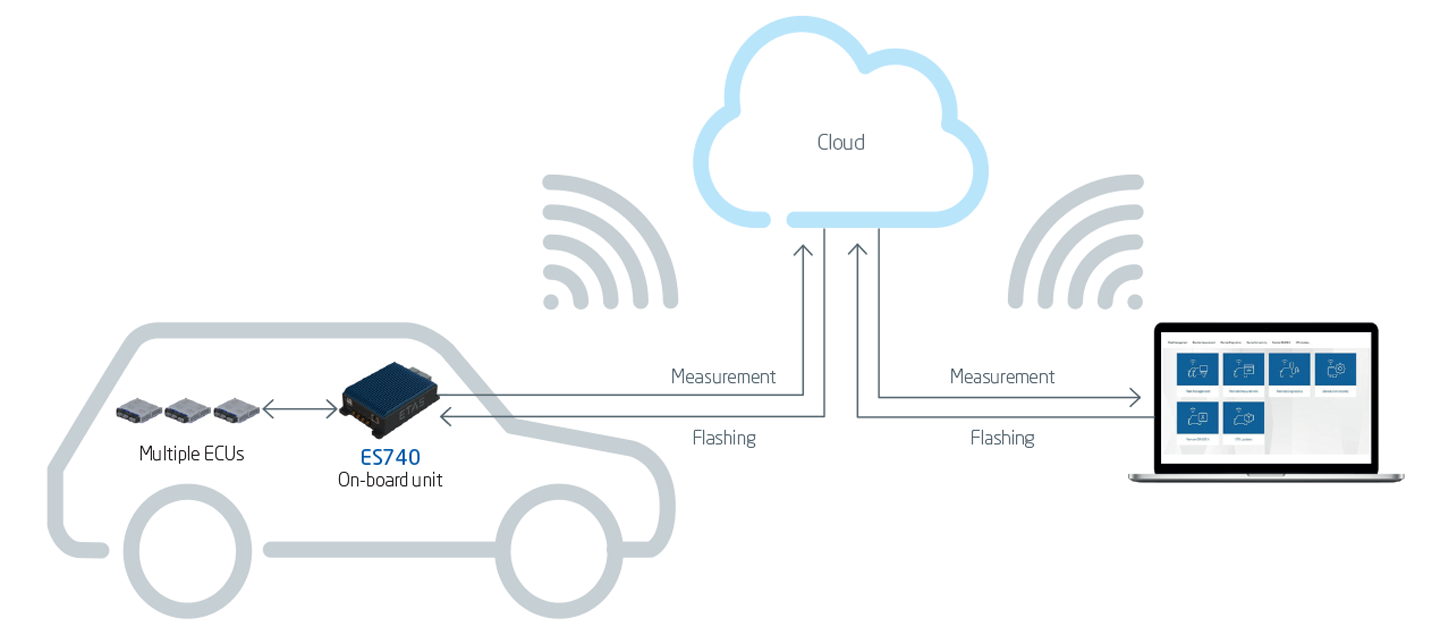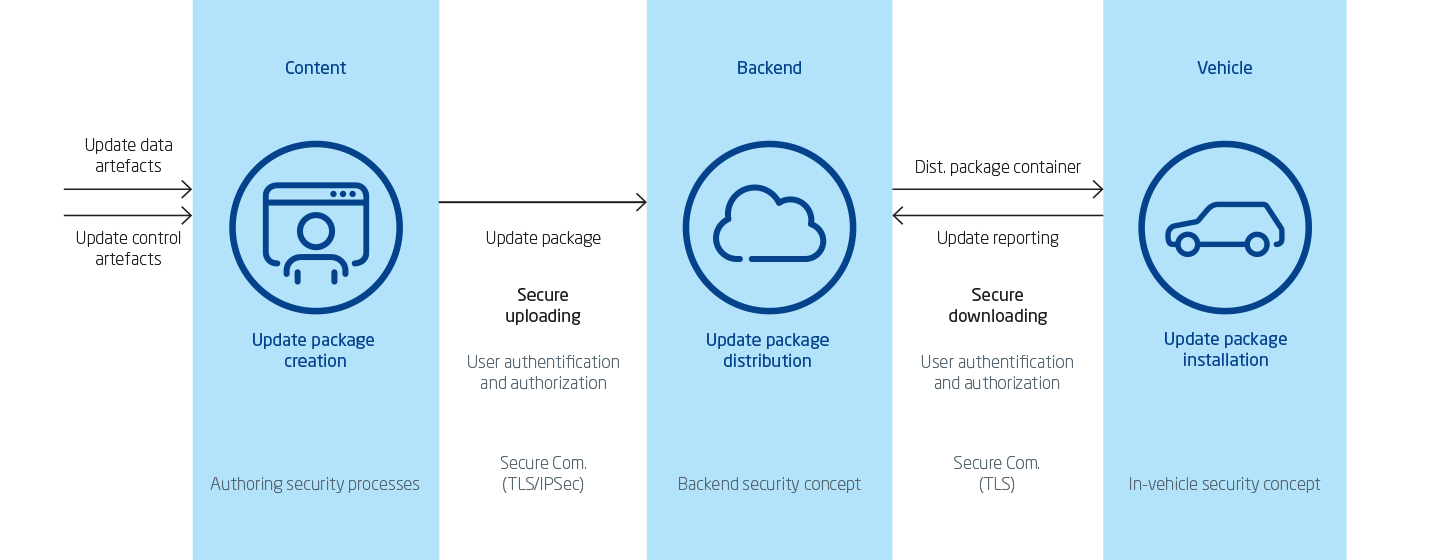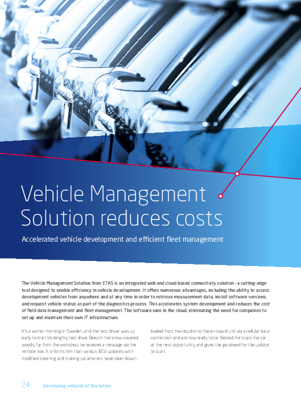Vehicle Management Solution reduces costs
Accelerated vehicle development and efficient fleet management

The Vehicle Management Solution from ETAS is an integrated web and cloud-based connectivity solution – a cutting-edge tool designed to enable efficiency in vehicle development. It offers numerous advantages, including the ability to access development vehicles from anywhere and at any time in order to retrieve measurement data, install software versions, and request vehicle status as part of the diagnostics process. This accelerates system development and reduces the cost of field data management and fleet management. The software runs in the cloud, eliminating the need for companies to set up and maintain their own IT infrastructure.
It’s a winter morning in Sweden, and the test driver was up early to start his lengthy test drive. Deep in the snow-covered woods, far from the workshop, he receives a message via the remote box. It informs him that various ECU updates with modified steering and braking parameters have been downloaded from the cloud onto the on-board unit via a cellular data connection and are now ready to be flashed. He stops the car at the next opportunity and gives the go-ahead for the update to start.
It takes just a few minutes for the system to install the updates on the ECUs. Soon he is back on the road and, almost immediately, the car begins transmitting current dynamic measurement data as well as status information – all based on the new parameters – back into the cloud via the cellular data network. A development engineer back at headquarters can immediately access the data from the cloud, perform the next stage of the validation process and prepare further ECU updates if necessary, effectively creating a closed loop (Fig. 1).

This scenario is already a reality thanks to a reliable, secure, and forward-looking connectivity solution known as the Vehicle Management Solution (VMS). Offering a bidirectional communication channel between the vehicle and the cloud, the VMS handles procedures including remote flash, remote measurement, and remote diagnostics. Remote flash (firmware over-the-air, FOTA) involves flashing one or more ECUs over UDS on CAN. The remote measurement function records data on the CAN bus (as described in the example), while remote diagnostics involves running diagnostics from a distance. High data rates and low latencies can be achieved. Preparations are already underway for a cloud-based data analysis feature that will provide further innovative functions and services.
There are two primary components that make up the Vehicle Management Solution. The first of these is a core software module that provides a fast and secure communication interface between the vehicle, cloud, and services. The second is a data management module that organizes, analyzes, visualizes, and prepares the entire flow of data via the cloud.
The on-board unit is the hub of the Vehicle Management Solution in the vehicle. As well as recording measurement data and status information, it also controls data traffic and flashing. The initial VMS configuration includes the powerful new ETAS ES740 On-Board Unit. This is configured to handle highly demanding application scenarios. Nonetheless, ETAS intends to expand VMS compatibility step by step to include modules made by different manufacturers and modules with different performance configurations. One example is the incorporation of the even more powerful ETAS ES820 Drive Recorder.
Two companies have pooled their experience to develop and market this product. ETAS’ core competence lies in hardwarerelated functions and measurement and calibration tasks, while Robert Bosch GmbH offers expertise in backend and cloud services. At the start of 2019, the two companies combined their know-how in a new cooperation.
The VMS is the perfect tool for today’s highly challenging market environment. The increasing complexity of modern vehicles requires frequent software releases during the development process, and the subsequent real-world tests are both timeconsuming and labor-intensive. This results in very high costs overall. In addition, each development department at an OEM usually has its own test vehicle to carry out its own specific tests, which represents another huge expense.
The Vehicle Management Solution helps engineers cope with increasing complexity while simultaneously reducing development costs. Functions such as remote flash and remote measurement provide rapid feedback on modified parameters, reducing the time required to validate software versions. This provides an easy way of ensuring that vehicles are always running the latest version of the software. The VMS enables system experts to remotely supervise several vehicles at once.
Tasks in the vehicle itself are simplified, so that they can be initiated by any test driver. Major cost savings also come from the reduction in fleet size: a single test vehicle can be put to effective use by multiple departments, in some cases even at the same time. As a result of all these factors – and because the vehicle does not have to return to the workshop to be flashed – development times overall are shorter. Thus, the cloud-based system offers maximum flexibility by making development work location-independent.
A fleet management system is included in the VMS that makes it possible to manage, plan, control, and monitor large numbers of different vehicles. By clearly displaying vehicle-specific information, vehicle status, and vehicle position, the VMS ensures that fleet managers and development engineers always have a complete, up-to-date overview. The clearly structured web interface can be used in a standard internet browser.
Security was a key priority for the VMS development team. In-depth security is comprehensively assured along the entire chain, making it impossible for anyone to falsify the data passing through the various transmission paths and stations (Fig. 2).
The modular security concept was developed in collaboration with ESCRYPT, ETAS’ wholly-owned subsidiary and a leading provider of IT security solutions.
The Vehicle Management Solution is designed as “software as a service” (SaaS). The model includes operation of the VMS for the customer, and the relevant programs are designed to run on various public clouds. Analyses and evaluations are also executed in the cloud before being sent to the customer. Customers can connect their own applications to the VMS through defined interfaces. The advantages of this model are clear: the VMS software is always up-to-date, customers have no need for their own server, and no maintenance costs arise.
Summary
The Vehicle Management Solution speeds up vehicle development with its location-independent functions and offers significant cost-cutting potential. Regular updates ensure it is always up-to-date. A sophisticated security concept ensures maximum data protection and data integrity. All in all, the VMS is another step forward in the future of automotive development.
Authors
Axel Heizmann is Senior Marketing Communications Manager at ETAS GmbH.
Murat Yeter is Solution Manager for connected development at ETAS GmbH.

